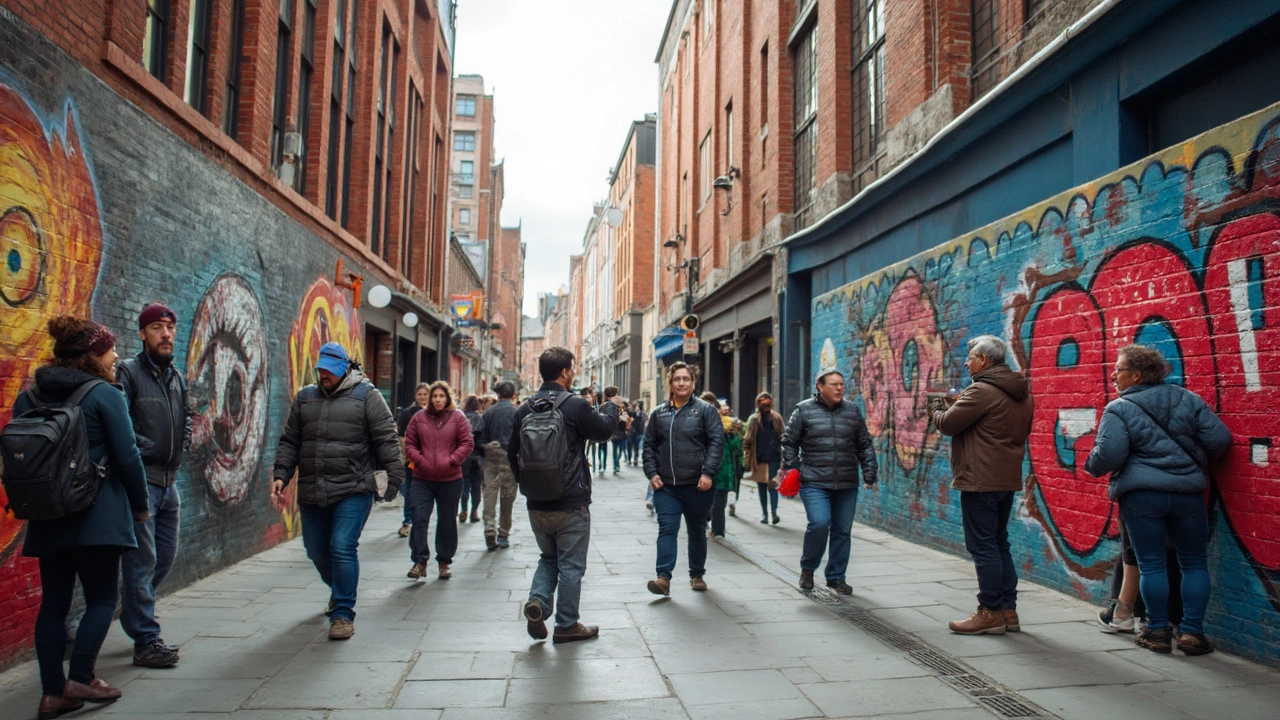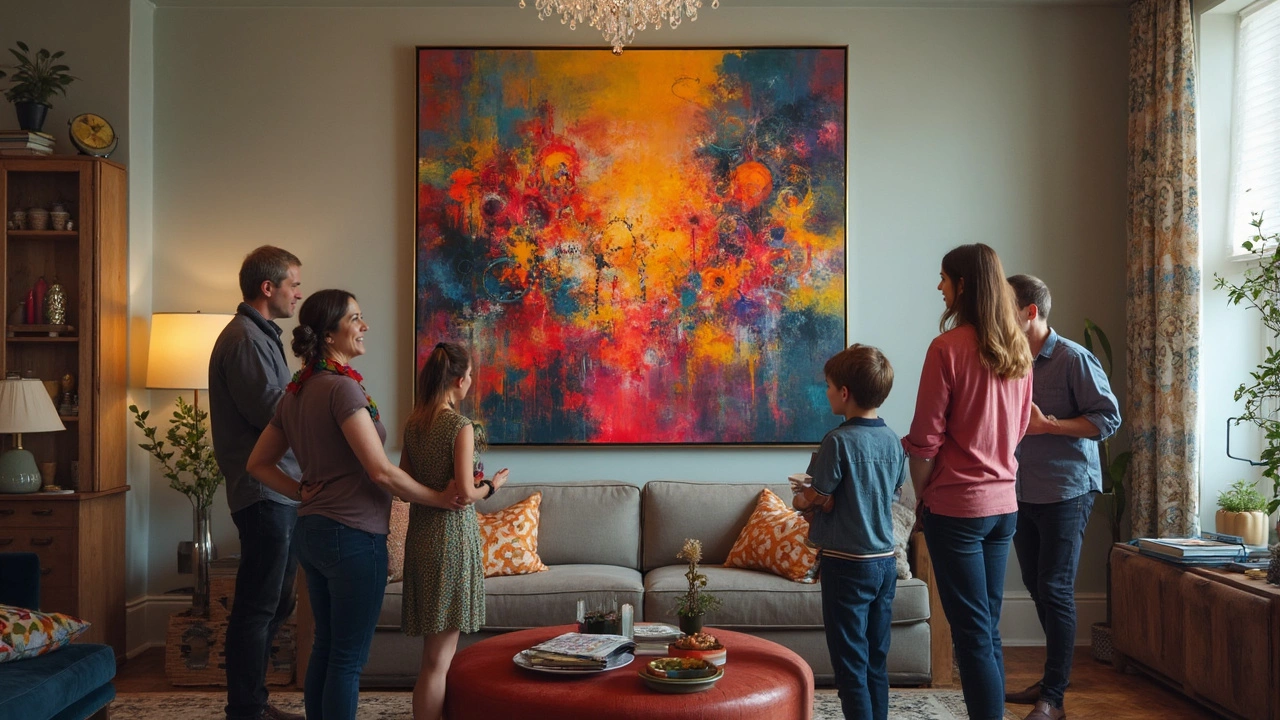Ever stood in front of a splatter of paint and wondered, why is this famous? Don’t worry, you’re not missing some secret code. The truth: modern art isn’t about hidden messages or high-society rules. It’s more about what you feel, not what you’re supposed to know.
People gravitate to modern art because it dares to bend or break the old rules. You don’t need a fancy background to appreciate a bold canvas or a weird sculpture. The real fun starts when you let yourself react honestly—maybe you smile, frown, or even roll your eyes.
Here’s a key tip: try asking yourself, “What does this remind me of?” or “How does this make me feel?” There’s no right answer. Suddenly, the world of modern art doesn’t seem so locked up or intimidating. In fact, it might even feel like an invitation to think differently or just have a laugh.
- The Bold Shift: What Makes Modern Art Modern?
- Feeling Over Facts: Why Emotion Matters
- It's Not Just in Galleries: Modern Art in Daily Life
- Breaking the Rules: Anyone Can Join In
- How to Actually Enjoy Modern Art
The Bold Shift: What Makes Modern Art Modern?
Here’s the deal: modern art started shaking things up in the late 1800s, and it turned everything people expected from art upside down. Before that, art was all about showing off skills—creating lifelike portraits or perfect landscapes. But then artists like Monet thought, “Why not focus on light and color instead of details?” Cue the start of big changes.
By the early 20th century, art took a hard turn from tradition. Picasso began breaking faces into cubes, while Kandinsky painted feelings instead of objects. The point? Art didn’t have to look realistic. It could be abstract, weird, or emotional, as long as it meant something to the artist (or the person looking at it).
And it didn’t stop there. Artists started using anything they could get their hands on: industrial metal, found junk, even urinals (Duchamp famously called a signed urinal art in 1917). Basically, if it made people stop and think, it counted.
Instead of sticking to rules, modern art became a big experiment. Here’s what set it apart:
- It chucked out strict traditions—artists cared more about ideas and feelings than copying reality.
- New materials and tools became fair game. Spray paint, photography, even trash showed up in art galleries.
- Anyone could have a shot; you didn’t need to study old masters or come from an art family.
- Breaking the rules wasn’t just allowed—it was cool.
Fast fact: According to The Art Market Report (2023), modern art now makes up over 40% of global art sales. That’s a massive chunk, proving just how popular—and valuable—this style of creativity has become.
This bold shift still inspires new trends. People love modern art because it feels open—and open to everyone.
Feeling Over Facts: Why Emotion Matters
Here’s a wild fact: a study from University College London looked at how brains react to different types of art. People’s emotional centers lit up way more when they viewed unpredictable modern art than when they looked at calm landscapes or old portraits. That’s a big reason why these wild splashes or chunky sculptures stick with you—they mess with your feelings first, not your logic.
Modern art flips the old way of thinking. Instead of worrying about the right answer or if you "get" the story, you can focus on what’s happening inside you. Maybe a piece reminds you of childhood, or maybe it just makes you angry. Both are valid. Nobody needs to be an expert to connect with modern art.
When people visit a modern art museum, they often have stronger reactions than in other galleries. Some say they feel confused or excited. That’s exactly the point—those feelings mean the art works. Even big names like Mark Rothko or Yayoi Kusama wanted viewers to feel something big, not just stand and nod politely.
Curious what kind of emotions you might run into at a modern art show? Check this out:
| Emotion | Common Triggers in Modern Art |
|---|---|
| Surprise | Bizarre shapes, bright colors |
| Curiosity | Strange materials, odd placement |
| Joy | Playful themes, bold energy |
| Confusion | Ambiguous subjects, mixed media |
| Calm | Simple patterns, balanced color blocks |
If you want to really get into a piece, try these quick steps:
- Look for a few seconds without overthinking.
- Notice your gut feeling: excited, annoyed, peaceful, or even bored?
- Ask yourself why it gives you that vibe.
- Don’t be afraid to walk away and return with fresh eyes.
With modern art, your mood sets the pace. That’s why so many people find it refreshing compared to more traditional art appreciation rules. You’re allowed to feel, not just analyze.

It's Not Just in Galleries: Modern Art in Daily Life
When people think about modern art, their minds usually go straight to museums and fancy gallery openings. But honestly, you’re running into modern art everywhere—down the street, in your own home, and even on your favorite coffee cup. It’s worked its way into the stuff we use every day.
Take street art and murals for example. Cities like Berlin and New York are full of bold, colorful paintings right on the sides of buildings. A 2023 survey found that 65% of big cities in Europe have official mural programs supporting new artists. These aren’t just random doodles—they’re public works of art that get people talking or just brighten a walk to work.
Designers grab ideas from modern art too, so you’ll spot abstract shapes and wild colors on everything from sneakers to phone cases. Ever notice how brands like IKEA or Nike launch products with splashy, blocky patterns? That’s straight out of the modern art playbook. It keeps things feeling fresh and fun, not just functional.
Even digital spaces get a dose of modern art. Emoji sets, filters on Instagram, and those famous squiggly backgrounds in tech ads all borrow from modern or abstract art. Companies know people connect with bold imagery, so it pops up on websites, apps, and even billboards.
If you’re itching to sprinkle some modern art into your routine, here are a few easy ways:
- Swap your phone wallpaper for an abstract design or bold color block.
- Decorate your space with a funky print—there are tons of affordable options online.
- Try an art-making app to play with digital shapes and textures—no art school required.
Modern art isn’t just for galleries. It’s shaping what we wear, how we decorate, and even how we scroll online. Next time you spot a wild color combo or a clever mural, recognize it for what it is—a piece of modern art, right in the middle of everyday life.
Breaking the Rules: Anyone Can Join In
If you think you need a fancy degree to make or enjoy modern art, you’ve been misled. The best thing about this scene? Rules get tossed out the window. Famous names like Jean-Michel Basquiat and Yayoi Kusama didn’t follow the old playbook. Basquiat started out with graffiti on city walls, and Kusama made her mark by covering things with dots. Neither cared much for what was considered “proper” art back then.
Modern art really opened doors for self-taught creators and rebels. The outsider art movement took off when museums began to show work by people far outside the academic fold. Museum of Modern Art in New York gave exhibits to artists who had never set foot in a traditional art school. Today, it’s common for galleries to spotlight creators discovered on Instagram or TikTok. The digital age has kicked open the door even wider.
Anyone can make something that sparks a reaction or starts a conversation. In 2019, Italian artist Maurizio Cattelan taped a banana to a wall at Art Basel Miami Beach and called it “Comedian.” It sold for $120,000, mostly because people couldn’t stop talking about it. Sound ridiculous? That’s the point: modern art nudges you to question what counts as art in the first place.
- Lots of modern artists use cheap materials: cardboard, plastic bags, even found junk.
- You don’t have to “draw well” — it’s about getting ideas and feelings out in the open.
- Public art projects often ask regular folks to join in, painting murals or building sculptures together.
Want to get started yourself? Here are two quick tips:
- Grab anything—markers, magazine clippings, even food—and create.
- Share your work, online or on a wall at home, and see what friends think. There’s no wrong answer here.
With modern art, the only real rule is: don’t worry about rules. You might even discover a side of yourself you never knew.

How to Actually Enjoy Modern Art
If you’ve ever stared at modern art and felt confused, you’re not alone. It’s normal! The trick isn’t to “get it” right away. Instead, think of modern art like a new kind of music—it takes time, and sometimes a little guidance, to really click. Here’s how to make the most of your next gallery visit or scroll through Instagram:
- Slow down. Don’t rush past paintings or sculptures. Give yourself a few minutes with each piece. The first impression is never the whole story.
- Read the wall labels. Museums usually toss in nuggets about the artist or what inspired the work. These blurbs can totally flip your perspective—or at least give you something to talk about.
- Ask questions—out loud, if you want. "Why did they use these colors?" "What does this shape remind me of?" You’d be amazed how kids do this instinctively, and it actually works.
- Make it about you. There’s no magic answer. Art like a big splash of color or a smudged photo can spark memories or moods. That’s the whole point for a lot of artists from the 20th century up to now.
- Mix up how you see it. Try looking at the art from a couple of steps back, then up close. Sometimes hidden details pop out.
Fun fact: studies at major museums, like MoMA, show that most visitors spend less than 30 seconds with each artwork, but those who linger walk away feeling more inspired and even happier. So just hang out for a little longer than usual and see what happens.
| Time Spent Per Art Piece | Reported Satisfaction |
|---|---|
| 30 seconds or less | 55% |
| 1-2 minutes | 77% |
| 3+ minutes | 89% |
If you’re at home, swipe through art apps or follow museum accounts on social media. Challenge yourself to “like” or comment on something you wouldn’t usually pick. The more you see, the more modern art opens up.
Last tip: remember, art is for everyone—not just experts. If you hit a wall, try seeing what stands out rather than what you "should" understand. You might surprise yourself and find a favorite new piece just by being open-minded.

